In this section:
| Pre-Blue Book pictures, 1947 (This page). | |
| Pre-Blue Book pictures, 1950 - 1951. | |
| The McMinnville photographs by Paul Trent. | |
| The Lubbock Lights photographs. | |
| 1953 - 1954. | |
| 1957. | |
| 1958. | |
| 1959. | |
| 1962 - 1966. | |
| Various other Blue Book photographs. | |
| Blue Book, the end. |
In 1947, before and after the so called first observation of so called flying saucers by Kenneth Arnold, and the same period than the infamous Roswell event, the Army Air Force who would become the US Air Force coincidentally just after the Roswell event, UFO observations and photographs were officially explained away as Balloons, meterorites, mirages and planet Venus by the military.
Project Saucer, then Project Sign, and finally Project Grudge reflected the evolution of the military's ideas about the phenomenon: first an excited interest, then a discrete discomfort, and finally a policy of explaining away everything.
Project Blue Book started later, in 1952, and received the files of the previous projects. Captain Edward Ruppelt who looked again at the old data, wrote: "Everything was being evaluated on the premise that UFO's couldn't exist. No matter what you see or hear, don't believe it."
Here are some poor reproductions generally scanned from magazines and newspaper of some of the early pictures investigated in the pre-Blue Book period.
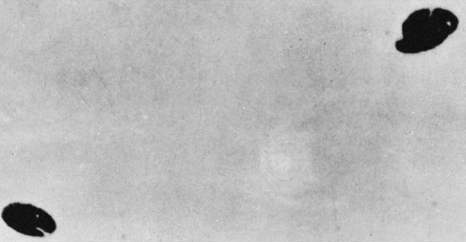
|
July 7th, 1947, Albert Weaver was able to take at least two photographs showing two disc-shaped UFOs over the town of Pontiac, Michigan.
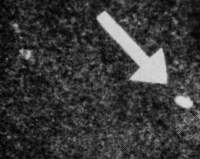
|
Ten days after the historical Roswell incident of July 4th, Frank Ryman, from the US Coastguard Service, managed to take a photograph of yet another white unidentified disc. This took place in the vicinity of Seattle, Washington State. The UFO can be seen in this photograph, enlarged twenty times. The US Air Force tried to play down the incident by saying that "it had only been an aerostatic balloon".
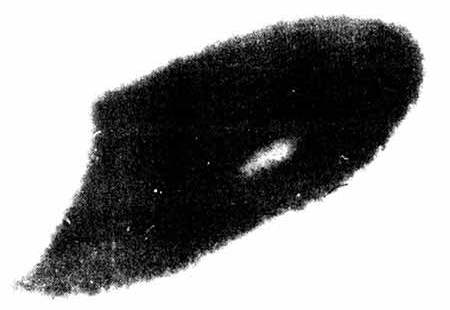
|
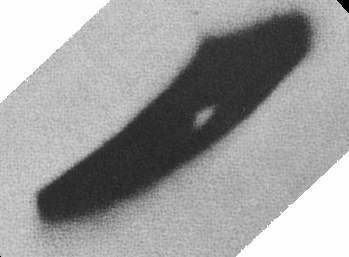
|
William A. Rhodes, a self-taught scientist, was inside his house at dusk on July 7th when he heard a noise. Strange as it may seem, he "thought it was a flying saucer". We must not forget though the term "UFO" had not been coined yet. Rhodes tells us that he took his plain Brownie box camera and quickly rushed out of the house. There he saw a strangely-shaped object -"like the heel of a man's shoe"- drifting away to the southwest. He had the time to take two pictures. He estimated the UFO to be 20-30 feet in diameter, traveling at speed of 100 mph, altitude 1,000-2,000 feet.
The plates were published in Arizona's Republic two days later, as upside down enlargements and cropped from the entire photographs. Ray Palmer in "Flying Saucer magazine" claimed the 64,000 newspaper issues were confiscated by the US Army Air Force, which it utterly untrue.
A week after the publication of the photos in the Arizona Republic, Rhodes was visited by an FBI agent and a Intelligence officer from Hamilton Camp (California) and asked numerous questions, he accepted in good faith to lend the photo to the Air Corps "for assessment". One month later Rhodes asked to have the pictures back but Washington replied that was not possible. The photographs, as in numerous other similar events, were never returned. Six months later, at the beginning of 1948, the Air Force asked Mr. Rhodes to come to Wright-Patterson Base, in Dayton, Ohio, for an interview. Rhodes replied that he could not come. Shortly afterwards, two members from the Air Technical Intelligence Center turned up at Rhodes' house and interviewed him for a second time. The photographer, tired of all that trouble, announced the officers that was the last time he would be talking about what he had seen and photographed in 1947.
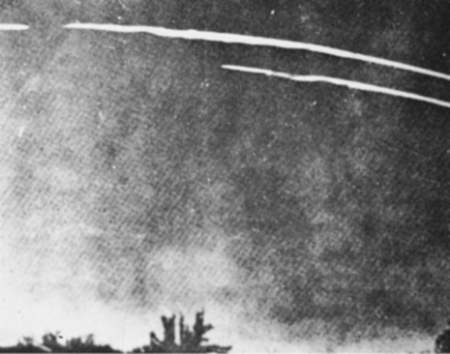
|
In July three glowing objects shot, like a flash of lightning, across the Louisville sky, in Kentucky. Practically all the witness assured they had seen totally circular bodies. The Louisville Weather Station, which centralized many of these statements, confirmed this description. Obviously, neither astronomers nor meterologists accepted the explanation given by the USAF, which tried to settle the matter once more by absurdly announcing that "it was just some meteorites falling..."
The problem was that meteors and fireball do not raise but fall down, and that no remains or impact has ever be found. The picture show an almost horizontal trajectory.
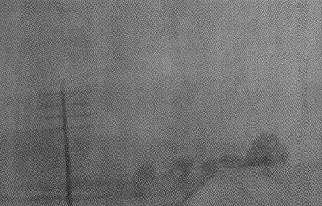
|
William Presley submitted the photo for analysis in July 1947. It was taken in Oak Ridge, Tennessee. Presley said the object flew, and went above a house. Unfortunately the picture as newspaper scan that I could find does not show anything.
On the 10th of February 1949, Colonel C. D. Gasser, of USAF's Air Material Command,cat the Engineering Field Office of the NEPA Project in Oak Ridge, met the Chiefcof the Investigation Section, Security Division, of the US Atomic Energy Commission,cG. J. Rathman, who had sent the photograph to Major Grant of the AMC at Wright-Patterson AFB.
The Air Force experts then decided the photograph was actually a development flaw: they said a drop of water or development liquid left this trace when it dried.
In 1950 and 1951, Oak Ridge was the theater of many other UFO events including radar detection and UFO chase by F-82 jet fighters.